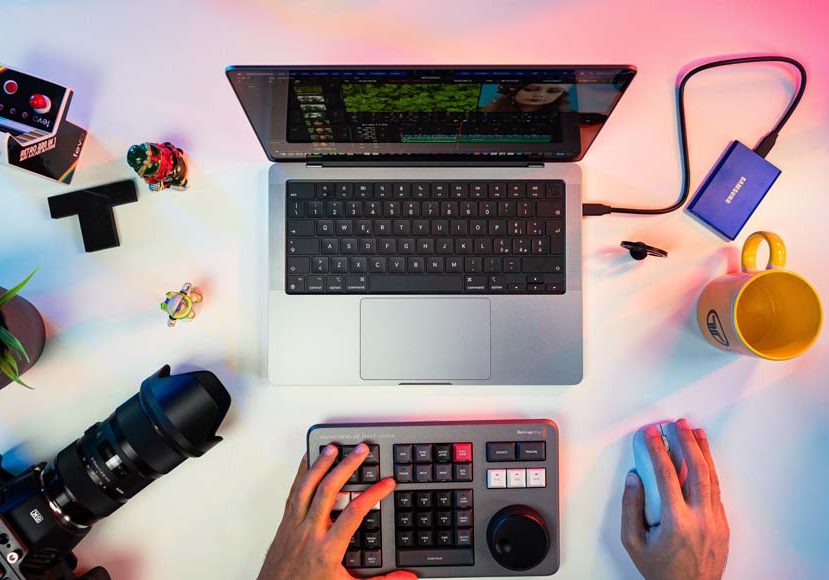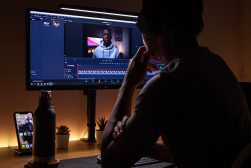
11 Different Types of Video Editing to Know (+ Trending Styles)
As a video creator, you should be aware of all the various types of video editing available to you, plus learn what styles are trending right now.
Learn Filmmaking | Learn | By Ashley Darrow
It’s hard to overstate the importance of knowing the different types of video editing in 2024.
Photographers looking to jump into videography, social media influencers who want to boost their following, and anyone who works with video and wants to go pro all need to understand basic editing concepts, software, and this year’s most trending video editing styles.
I got my start with editing by tinkering around with whatever software and footage I could get my hands on.
However, it wasn’t until I dug deeper into video editing techniques that I was really able to unlock my potential.
I’m going to walk you through different video editing techniques and the video editors you should know about and throw a few trending edits your way to kickstart your creativity.
Read our guide to the best video editing software if you need to download something to follow along with.
For now, let’s dive in.
What Are The Different Types of Video Editing?
1. Linear Video Editing
Linear video editing is where everything got started. This was the original way to edit video back when everything was shot on physical film.
You can see in this video just how many different machines and how much physical work went into the linear video editing process.
In fact, this clip shows a very old-fashioned setup before computer technology was available to aid the editing process.
Today, linear video editing is something of a niche specialty when filmmakers and artists are working with physical media rather than digital raw video files.
With that said, the history of linear video editing can still be felt. Many of the terms we use for editing as well as how we look at the timeline in programs like Premiere Pro all have their roots in old-school linear editing.
2. Non-linear Video Editing

Image Credit: Kelly
Non-linear video editing is the wave of the future, or at least it was years ago when it first became the standard way to edit everything from the morning news to the latest Hollywood blockbusters.
You’re probably familiar with non-linear editing. This is the type of editing that you would use with After Effects, Final Cut Pro, and even most mobile video editing apps.
Non-linear video editing allows you to import all of your raw video footage and then mix and match things on a timeline.
Best of all, it’s non-destructive. This means you can edit to your heart’s content without ever having to alter your original files.
Back in the days of physical film, you could only make so many edits before you destroyed the original media, and you had bigger problems on your hands
3. Offline Editing
Offline video editing is the process of transferring raw video footage from one device to an offline computer.
This type of editing allows you to work freely with the video files without requiring either live playback or having to keep the filmmaking equipment around.
This also lets you use more robust video editing equipment on a dedicated editing PC.
Like a lot of the steps on this list, offline editing is typically done in connection with other types of video editing.
4. The Online Video Editing Process
Online video editing really does say it all in the name. This type of editing uses online technology, such as web applications, to edit video.
How Much Do You REALLY Know About Photography?! 🤔
Test your photography knowledge with this quick quiz!
See how much you really know about photography...

Many of these web-based video editors only offer basic features. Simple tasks like cutting, adding essential motion graphics and text, and other basic features are what you can expect from these types of editors.
5. Cloud-based Video Editing
Cloud-based video editing allows you to use cloud computing to your advantage. This connects video editing teams in real time or allows individuals to collaborate on projects when their schedules don’t allow them to meet up.
Cloud-based video editing is available in a wide range of platforms including the software from Adobe and its Creative Cloud eco-system.
6. Simple Cuts
Simple cut is a type of video editing that is really just a part of the video editing process.
However, with the rise of smartphone cameras that can record a video and mobile apps that can edit those recordings, simple cut editing has become a central part of how we approach digital video.
If you’ve ever trimmed off the end of a video that was too long to upload to social media or cut out a boring section of a video before posting it, you’ve done simple cut editing.
All you really have to do for simple cut editing is to take out cuts from a larger video. Ideally, those cuts will be thoughtfully taken so that the remaining content flows well.
See more video cuts every filmmaker should know.
7. Bespoke Editing
Bespoke editing is another part of the overall picture of video editing.
Bespoke editing and freelance photography editing have a lot in common. You’ll be editing the work done by another visual artist.
This is often done when a filmmaker wants to work with a specific editor or, in the case of corporate video, where the work of trimming down raw video footage is outsourced to independent editors.
In my experience, bespoke film editors are often extremely skilled in their niche.
A bespoke film editor might be a wizard when it comes to effects and cinematic language while another might run an efficient operation for cleaning up footage from corporate events.
8. Insert Editing
Insert editing is also another key part of the overall video editing process.
The work of insert editing is done when you insert new footage into an existing clip.
This could be making a cut to a new scene or inserting footage from the live event during a pre-recorded news broadcast.
Insert editing can also be used for special effects work.
9. Assemble Editing
In the world of digital editing, you typically start off a project by importing all of your raw video files and clips into a single workspace.
While you’re busy putting all of these clips together to tell a story, what you are actually doing is assemble editing.
This is done when you assemble a wide range of clips together into a new, larger clip.
This assembled clip can even tell a completely different story than the separate pieces it was made of. You have a lot of creative leeway when it comes to assemble editing.
10. Live Editing
Live editing is incredibly compelling to watch especially in locations like a busy newsroom or a live sporting event.
Live editing is typically done from a control room where editors can see all of the action. There are a variety of programs ranging from some that might seem familiar, like After Effects, to specialty software for vision mixing that bring a live video broadcast together.
This is a fast-paced and demanding video editing environment. You might need to quickly cut from one story to breaking news or instantly shift the action to follow the fast pace of sports.
What Are The Different Types of Video Editing Software?
1. Desktop Video Editing Software
Desktop video editing applications are flagship pieces of software that are used by everyone from students to career professionals working on major motion pictures.
These pieces of software are the best of the best when it comes to video editing. Yes, some of them are very expensive and require pricey monthly subscription fees.
However, there really aren’t better programs out there than these.
On the note of cost, a few of the programs on this list are very affordable or even free.
There are open source video editing programs that can get you started without feeling like your wallet was the first thing that you had to cut.
Each of these programs has some trade-offs, strengths and weaknesses, and other considerations you need to make before picking the one that’s right for you.
A good example of this is the distinction between Premiere Pro and After Effects. Premiere Pro is used primarily for video editing while After Effects is used for creating and implementing special effects in your video.
Here’s a quick list of programs to get you started. One of the pieces of software on this list will be the right choice for your video editing.
- Premiere Pro (review)
- Filmora (review)
- After Effects
- Final Cut Pro
- Davinci Resolve (vs Premiere Pro)
- Apple iMovie
- OpenShot
- Shotcut
You can see the best computers for video editing and some great Premiere Pro alternatives.
2. Mobile Video Editors
Mobile video editors are lightweight and built to work on your iPhone, iPad, or your Android device.
The first thing you’re going to notice about these mobile apps is that they are lacking some of the features of their desktop counterparts.
This is to be expected given that these are optimized for working on your smartphone rather than being a one-stop solution for all of your video editing needs.
These apps also have a lot more variance when it comes to the features they offer as well as their user interface. I definitely recommend taking some time to try a few out so that you can find the one that works best for your needs.
I mostly use apps like Rush and iMovie for edits that I want to turn around quickly and post to social media.
These mobile apps can definitely get a little clunky when you try to do anything longer than a snappy Tick Tock or YouTube video.
Mobile photography and mobile video have only gotten more important in the last few years. If you’re looking to start making more vertical video on the go, check out one of these apps.
- Adobe Rush
- iMovie
- Video Editor
- LumaFusion
- GoPro Quick
- InShot
- RTRO
3. Web Video Editing Apps

Veed.io is just one of many browser-based editing tools at your disposal
We do live in a new digital world and you no longer even need to download software to start editing video.
There are plenty of web-based video editing applications out there. These have increasingly impressive video editing features that are starting to rival their mobile app counterparts.
I want to be very upfront about what these web-based video editor applications can accomplish. These definitely cannot replace full force video editing software.
These web applications are only designed to cover basic editing techniques. You’ll be able to cut your video files, move some clips around, and add some basic effects and text here and there.
You can make great use of these web apps if your main goal is to do basic editing and clean up raw footage.
This can be ideal for someone who just needs to edit video for social media—especially if you don’t like the interface on any of the mobile applications I mentioned.
Many of these web apps are free, only require a sign up, or have a monthly subscription. They definitely offer some of the most affordable options for video editing on the go.
- Veed.io
- ClipChamp
- Frame.io
- Vimeo Create
- Edit.Video
- Adobe Online Video Editor
- Canva
- Flixier
See also what free video editing software is best for beginners?
4. Film, VHS, and Physical Media Editing
Sure, you could try to find an old Steenbeck and get that flatbed editor working again, but there are other ways to approach editing physical video film in a digital world.
The easiest way to go about editing film, VHS, and other physical video media is by converting it to digital and then editing it using one of the other three methods I mentioned above.
This is great if you have some old family 8mm videos laying around that you want to clean up and share or if you just shot a movie on 16 mm.
You can either buy a film scanner designed to work with the moving image or you can send it off to an independent lab that will develop and scan your film for you.
Either way, you’ll wind up getting a digital file that you can edit in post-production just like you would any other movie file.
Then again, I’d said the coolest thing to do would be to get an old Steenbeck flatbed editing table and get it working again!
What Are Some Trending Video Editing Styles in 2024?
1. Vertical Video
Long gone are the days when vertical video was seen as an “incorrect” way of shooting.
Well, they might not be long gone, but they are certainly on the way out. Vertical video is starting to stand up as its own, unique art form.
Vertical video works great for content that is specifically designed to be enjoyed on a smartphone.
Shooting vertical video does mean that you need to start thinking outside of the box.
Generations of video creators have trained themselves expressly on horizontal modes which means that vertical video leaves us in a little bit of uncharted territory.
As you can see in this example, world-famous musicians are starting to release vertical video as are news agencies and even your everyday content creators.
Now’s the perfect time to try out a vertical video.
2. Livestream Video Editing
Live streaming is still one of the most popular video trends that’s endured over the last several years.
Audiences just seem to love watching live videos, whether it’s video games streamers, live sports, or just their favorite internet personalities having a discussion.
Editing for lives streaming involves preparing graphics for the stream, cutting clips from a live show, and editing down a livestream into a video you could upload to YouTube later on.
This means that knowing how to edit live video is one of the best skills that you can develop in terms of video editing.
3. 360 Video

Image Credit: Maik Kleinert
360 video is another interesting contender when it comes to the popularity of video editing techniques.
360 video displays all of the action on a scene and has plenty of untapped artistic potential. There are amazing action 360 videos, as well as hilarious comedy videos, shot using 360 cameras.
If you’re more business focused, you’ll be glad to know that 360 videos have a high click through rate.
4. Short-form Video
Short form videos have become all the rage since the popularity of TikTok started to surge.
There is no one definition for what counts as a short form video. Twitter allows short form videos just over 2 minutes long while TikTok caps things at around 60 seconds.
The goal of short form video is to be concise with your storytelling without sacrificing on quality.
This trending editing style is all about making the most of only a few minutes, or even seconds, a video.
5. Square Format Video
Traditional approaches to aspect ratios have never been more shaken up. If vertical video wasn’t enough for you, square format video is also making a splash this year.
After all, it’s hip to be square.
Facebook recently announced new guidelines that favor square format video.
A wide range of devices are able to display square format video which means that a few social media platforms are changing up what they can display.
Square format is certainly going to create some new artistic challenges for anyone looking to cut video for social media.
6. Repurposed Video Edits
So, you just finished shooting a 15 minute long YouTube video which means you might be wondering what else you could do with that footage?
Repurposing existing video content for other platforms and other uses has been one of the most successful and trending video editing styles for a while now.
That 15 minute YouTube video could be cut into a few short form videos for platforms like Instagram or TikTok.
You could also cut shorter clips from that video to help promote the video and extend the life of the work that you put into the final cut.
7. Use of AI Video Editing Tools
Another trending video editing technique involves using AI video editing tools.
You can find AI editing tools in dedicated web-based applications as well as in popular software like Adobe Premiere Pro.
AI programming is being used at every level of video editing whether you’re looking to generate some unique effects or you want to get a hand with the basic editing you’ll be doing.
8. Interactive Video
Interactive video gives the viewers some method of engaging with the video content beyond just watching and listening.
This could be as simple as a video that welcomes users to a website or an advertisement that has an integrated link to the product being shown off in the video.
In any case, videos that are able to interact with viewers are becoming more popular. Creating videos that engage with your audience on a new level is a great way to explore the limitations of creating engaging video.
This doesn’t just have to be for advertising. You can use interactive video for storytelling and artistic applications as well.
9. TikTok Videos
TikTok is still one of the most popular social media websites and its use is only going up. TikTok is also revolutionizing video content and has even caused dramatic changes to other apps as Instagram, YouTube, and others attempt to copy what made TikTok so successful.
Many of the video trends that we see today get their origin on TikTok. Getting active on this app is a great way to pick up on video trends before they start popping up on other social media platforms.
10. Use of Trending Audio
Sometimes, video editing is all about the audio landscape you’re presenting to your viewer. Nowhere is this more important than when trying to capture some of the momentum of a new video trend.
Audio clips are making and breaking trending videos on social media. Whether it’s a part of a song or a viral meme, an audio clip paired with your existing video can go a long way to helping you promote your video content.
Apps like Instagram and TikTok even have built-in tools that allow you to find trending audio clips and incorporate them into your videos.
Next Steps For Video Editing Styles And Trending Tips
Now you’ve got a basic working knowledge of video editing techniques, a list of software to try out, and some trending video editing styles to use with your own footage.
I’d love to hear which of these video editing styles you’re going to try first and the software you’ll be using to get the job done. Let me know down in the comments.
If you’re looking for more photography and video editing tips, make sure to check out our other articles.

Check out these 8 essential tools to help you succeed as a professional photographer.
Includes limited-time discounts.













